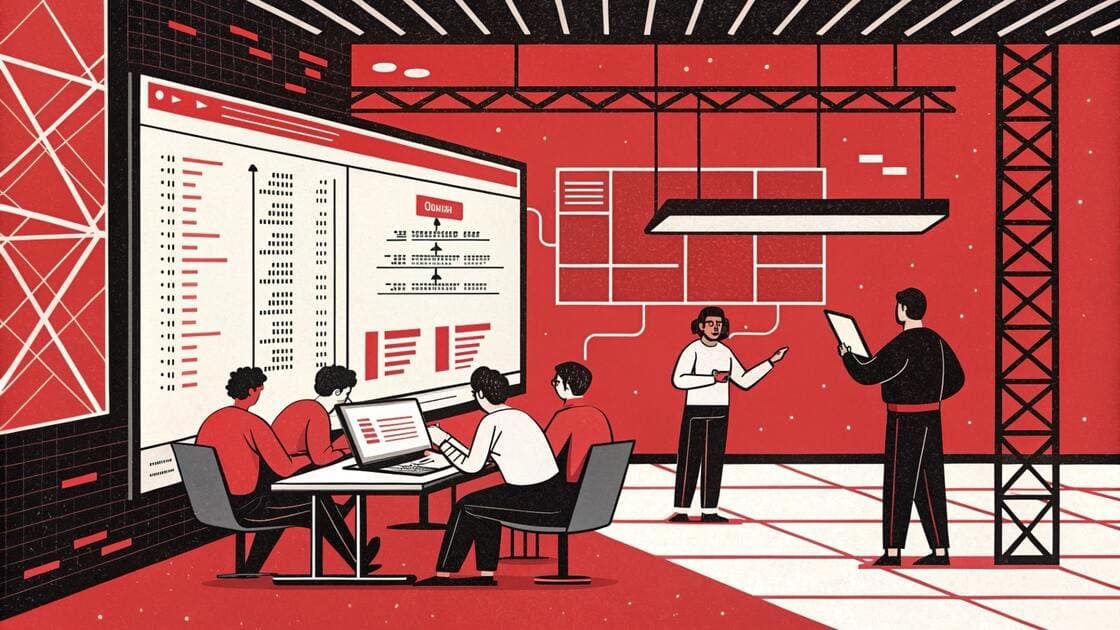
In the demanding field of technology, it's not uncommon for technical leaders to fall into some familiar traps. Some get engrossed in coding, forgetting to balance this with their other critical responsabilities. Others might not give enough attention to their team's needs or run away from people management tasks. Effective communication with the team and other colleagues, as well as sharing key updates, is absolutely vital. It's also essential to give credit where it's due and acknowledge the team's hard work. In this article, we're going to dig into these common mistakes and provide some useful tips on how to avoid them.
In the realm of technical leadership, various mistakes can negatively impact a leader's performance and effectiveness. Some of the most common mistakes and how to avoid them are described below:
One of the frequent mistakes that technical leaders make is spending too much time on coding and neglecting other important responsibilities. It is understandable for a technical leader to maintain programming skills, but they should ensure they find a suitable balance between coding and fulfilling other essential tasks such as team management and communication with other members of the organization. Allocating sufficient time for these responsibilities can improve the efficiency and overall performance of the team.
Try implementing a time management method, like the Pomodoro Technique, to help you allocate your time efficiently. This could involve dividing your day into blocks of time dedicated to specific tasks, such as coding, team management, and communication. Keep an eye on the time you spend on each task and adjust as needed. Remember, coding is definitely important, but your role as a technical leader also includes managing your team and communicating with other parts of the organization. Don't forget about these crucial tasks - balance is key. Using productivity tools like calendars or task management apps can also help you keep track of your tasks and manage your time better. And last but not least, delegate when you can. You're part of a team, so leverage your team's skills to help manage the workload.

Another frequent mistake is not prioritizing the team's needs. A technical leader must ensure they understand the difficulties and concerns of their members, as well as providing them with the necessary resources and support to carry out their work efficiently. Ignoring the team's needs can lead to frustration, lack of motivation, and decreased performance. By prioritizing the team's needs and providing an adequate work environment, the technical leader can promote collaboration and collective success.
A solid recommendation for staying in tune with your team's needs is to have regular check-ins or feedback sessions with your team members. This will allow you to understand their concerns, challenges, and what resources they might need to work more effectively. It also helps to foster an open-door policy where team members feel comfortable coming to you with their needs or ideas. Remember, fostering a culture of open communication and responsiveness goes a long way in ensuring your team feels their needs are heard and addressed.
People management is a fundamental part of technical leadership, and many leaders make the mistake of not assuming these responsibilities. It is important for a technical leader to actively involve themselves in the professional development, motivation, and support of their team. We must remember that the team's success largely depends on effective people management. Taking responsibility in this area, reconciling individual needs with organizational objectives, will foster a productive work environment and greater team satisfaction.
One handy recommendation to ace people management is to invest in your emotional intelligence. Understand that every member of your team is unique, with distinct needs, motivations, and work styles. Regular one-on-ones, team meetings, and open feedback channels can be beneficial to stay in the loop. Don't forget to celebrate wins and appreciate your team's efforts to boost their motivation. Lastly, continuous learning on leadership and management practices can go a long way in enhancing your people management skills. Always remember, leading a team isn't just about hitting goals, it's also about growing your people along the way.
Resources:
In technical leadership, effective communication is fundamental for the team's success. Clear and open communication channels must be established, both with the team and with other members of the organization.
Communication with the team is essential to establish a good relationship of trust and collaboration. Technical leaders should be available and willing to listen to their team's concerns and suggestions. In addition, it is important to communicate the objectives, goals, and expectations clearly and concisely to avoid misunderstandings and keep everyone aligned.
For boosting team communication, you need to establish a culture of open communication. Encourage your team to share ideas, suggestions, and issues freely without fear of judgement. Next, use simple and clear language when setting goals or giving instructions to avoid confusion. Don't forget about two-way communication; active listening is equally important. Also, regular team meetings and check-ins can be useful for catching up and resolving any issues. And of course, leverage digital tools like collaboration software to keep everyone connected and in the loop. Lastly, remember that good communication is not just about work; sometimes, casual chats can also help build stronger bonds among the team members. So, take some time for small talk and team-building activities.

In addition to communicating with the team, technical leaders need to have effective communication skills with other members of the organization. This involves transmitting information in a clear and understandable way, establishing trusting relationships, and collaborating productively. Communication with other departments and teams is key to the progress and success of the project as a whole.
Make a habit of reaching out and connecting with people outside of your immediate team. You could schedule regular catch-ups or informal chats with colleagues from different departments. This can help to build relationships and encourage a sense of unity across the organization. Also, be proactive in sharing updates and progress reports related to your team's work. This transparency can help others understand your team's role and how it contributes to the bigger picture. And always be open to feedback – it's a two-way street! This can lead to productive conversations and innovative ideas. In essence, communication is not just about talking, it's about connecting, so make every interaction count.
Resources:
In technical leadership, it is fundamental to recognize and appreciate the team's good work to encourage an environment of motivation and satisfaction. Recognizing good work strengthens the trust and commitment of team members, thus promoting greater performance and a sense of satisfaction in their work.
Recognizing the team's good work involves valuing and highlighting individual and collective achievements. This can be done through various strategies, such as public congratulations, highlighting successes in team meetings, or rewarding effort and results obtained.
It's important that this recognition is sincere and specific, highlighting the particular contributions and the positive impacts they have had on the project or organization. In addition, the opportunity can be taken to highlight the learning and skills acquired during the process.
In addition to recognizing good work, technical leaders must provide constant motivation and support to their team. This involves setting clear goals, providing constructive feedback, and offering opportunities for development and professional growth.
It's crucial to listen to the team's needs and concerns, as well as offer necessary resources and tools to facilitate their work. Similarly, creating an environment of trust and closeness allows team members to feel supported and motivated to give their best.
Effective technical leadership is based on recognizing the valuable work of the team and providing the necessary support for their growth and success. By doing so, the working relationship is strengthened, productivity is promoted, and a respectful and rewarding work environment is created for all those involved.

Resources:
When leading technical teams, it is crucial to avoid falling into management pitfalls that can hinder success. These pitfalls include not aligning with the system's key attributes, avoiding micromanagement, and refusing to grow and develop personally.
A common mistake technical leaders make is not understanding and aligning adequately with the system's key quality attributes. It is essential to have a clear understanding of the system's requirements and goals, as well as expectations for performance, security, and scalability.
To avoid this mistake don't be a stranger to your system's key quality attributes! Dedicate time to deep dive into understanding your system's requirements, performance metrics, security standards, and scalability potential. Regularly sync up with the system architects or the relevant team members to stay updated on any changes or enhancements. Also, consider training sessions or workshops to get a better grasp of these key attributes. Remember, aligning your work with the system's key qualities is not a one-time job; it’s an ongoing process. So, keep your knowledge fresh and stay tuned in to updates. In this way, you'll make decisions that really gel with your system's needs.
Micromanagement can be detrimental to the team, as it limits their autonomy and creativity. To avoid falling into this trap, it is important to trust team members and give them the freedom to make decisions and complete their tasks. Encouraging an environment of trust and empowerment will allow the team to develop and progress.
Let them make some decisions and show off their skills. Create a culture where mistakes aren't feared but are seen as learning opportunities. Check in on progress, sure, but don't hover. So, step back, relax, and watch 'em shine!
Technical leaders must be willing to continually grow and develop, both in their technical skills and leadership abilities. Refusing to grow can limit the potential of the technical leader and negatively impact the team. It's important to seek out learning opportunities, receive feedback, and be open to constantly improving.
Staying the same won't do you or your team any good. You need to keep learning - not just about tech skills, but also leadership topics too. Try to consume any new knowledge whenever you can. Find learning opportunities, get feedback, and always strive to be a better version of yourself. Remember, you're leading the way, so your growth matters big time. Keep evolving, and you'll lead a team that's dynamic and successful.

Resources:
In technical leadership, it is crucial to find an appropriate balance among the responsibilities one has. This involves understanding the importance of prioritizing tasks and knowing how to balance coding with other important tasks. Let's look at two key aspects related to this balance:
As a technical leader, it's essential to have clarity about the different responsibilities one has and to prioritize them effectively. This involves identifying the most critical and urgent tasks, and ensuring enough time and effort is dedicated to each one of them. Prioritizing appropriately allows one to avoid spreading their focus and concentrate on what really matters for the team and the project.
It's crutial to determine and correctly prioritize your responsibilities. This process includes pinpointing those tasks that are most critical and time-sensitive, and then dedicating an appropriate amount of your time and effort to each. By dedicating your focus on priority tasks rather than spreading it across all responsibilities, you ensure the most valuable aspects for both your team and project receive the attention they deserve.
While it's natural for technical leaders to have coding skills and enjoy participating in writing code, it's equally important to recognize that there are other crucial tasks that require attention. These tasks may include project planning and coordination, resource management, internal and external communication, and strategic decision-making. An effective technical leader should understand the importance of balancing their time and energy between coding and these additional responsibilities, to ensure a robust and well-rounded approach in their leadership role.
A practical recommendation is to establish clear boundaries and schedules. By designating specific time for coding and other managerial tasks, technical leaders can create a structure that allows for immersion in the coding process without neglecting other vital leadership duties. Regularly assessing this balance and making adjustments as needed is key. Seeking feedback from team members and other stakeholders can also provide valuable insights into how effectively this balance is being maintained.
Resources:
Effective collaboration is fundamental in technical leadership to achieve solid teamwork and successful project management.
Smooth and clear communication with the team is essential in technical leadership. This involves sharing relevant information, establishing an open line of communication, and maintaining constant and effective communication. Promoting active participation of the team and listening to their opinions will foster a collaborative environment and motivate members to contribute with ideas and solutions.
This can be achieved by regularly scheduling time for team members to share ideas, concerns, and feedback, both in formal meetings and informal discussions. Using collaboration tools that fit the team's workflow and creating a safe space where everyone feels comfortable speaking up can enhance this process. Leaders should lead by example, being transparent, accessible, and responsive, and should recognize and celebrate contributions from all team members. This practice not only strengthens the team bond but also leads to more innovative solutions and successful project outcomes.
Teamwork is essential for successful technical leadership. Assigning tasks and responsibilities in a clear and equitable manner, taking into account individual skills and strengths, will facilitate collaboration and ensure an efficient workflow.
Moreover, it's important to set clear goals and objectives, aligned with the vision and mission of the organization. Defining roles and responsibilities, establishing deadlines, and monitoring project progress are key aspects of project management in technical leadership.
Proper delegation of tasks also plays a crucial role in effective collaboration. Trusting team members and allowing them to take on responsibilities encourages their professional development and strengthens trust and commitment.

Resources:
Personal growth and development are fundamental aspects for technical leaders. To succeed in their role, it's important for them to strive for continuous improvement in both their technical skills and leadership abilities.
Personal growth involves being open to continuous learning and acquiring new skills. Technical leaders must be willing to step out of their comfort zone and seek opportunities for development at both the professional and personal level.
To improve personal growth, attend workshops, read relevant materials, or even consider mentoring and coaching. Embracing feedback from peers and supervisors can provide valuable insights for improvement. Setting specific and measurable goals, coupled with a commitment to self-reflection and adaptation, will further aid in continuous development and refinement of both technical skills and leadership abilities. This commitment to personal growth will not only benefit the individual but will also have a positive impact on the team and the broader organization.
Technical leadership requires both solid technical skills and effective leadership abilities. While being technically proficient is the cornerstone of your role, developing leadership abilities is what elevates your contributions to the organization and the team you lead.
Technical skills are the foundation of your career. They encompass the knowledge and capabilities needed to handle specific tasks related to software development, such as coding, debugging, system design, or understanding algorithms. Constant learning and upskilling in the technological domain are essential due to the rapidly evolving nature of the industry. Keeping up-to-date with new languages, tools, methodologies, or system architectures is critical. Participating in specialized training, attending industry conferences, and staying updated through tech blogs and forums can help enhance these skills.
On the other hand, leadership skills are the glue that holds the team together and drives it towards success. A good leader is an excellent communicator, motivator, and problem solver. Leadership is about influencing others positively to achieve common goals. This includes being able to delegate effectively, managing conflicts, encouraging a positive team environment, and inspiring and motivating your team to do their best. Leadership abilities can be improved through experience, mentorship, self-reflection, and various leadership development programs.
Striking the right balance between sharpening your technical skills and nurturing your leadership abilities is key to thriving in a technical leadership role. Remember, it's not just about being a master in your technical field; it's also about guiding, empowering, and supporting your team towards shared goals.
Resources:
Leading a technical team effectively is much like being prepared with an emergency kit; you must have the right tools and strategies at your disposal to respond to various challenges. This 'kit' for technical leadership should include the following:
By meticulously incorporating these elements into the leadership approach, technical leaders arm themselves with an 'emergency kit' capable of navigating the complex and often unpredictable world of technology. It's not merely about avoiding pitfalls but actively creating a culture where success, collaboration, innovation, and growth are part of the daily routine.













© 2025 Mario Lemes Medina. All Rights Reserved.